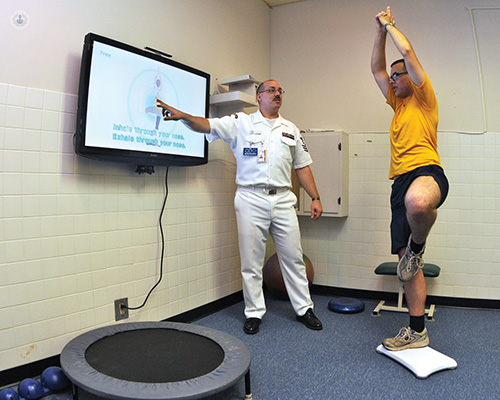Telerehabilitation
Dr Piera Santullo - Physical medicine & rehabilitation
Created on: 08-02-2013
Updated on: 01-10-2024
Edited by: Sophie Kennedy
What is telerehabilitation?
Telerehabilitation is a form of healthcare that allows rehabilitation services to be delivered remotely to patients at home or in another care setting. Telerehabilitation uses different forms of communication technology, such as videos, websites, and computer programmes to guide the patient and lead them through the specific type of rehabilitation needed in their individual case. Equipment may also be provided by the hospital or doctor that the patient can use at home.

What is telerehabilitation?
Telerehabilitation involves a rehabilitation specialist or healthcare practitioner setting a number of objectives for the patient, such as physical movements, exercise, or mental exercises using a range of devices, programmes and computer applications for guidance. Telerehabilitation programmes often feature two-way interactive videos that allow the doctor to monitor the patient's development.
Remote rehabilitation care is particularly useful for patients who have difficulty travelling to hospitals or clinics to undergo therapy, especially if living in a rural location, or for patients who are not well enough to travel regularly.
Telerehabilitation allows patients to be in control of their own recovery and health management where appropriate. It also enables more personalised care, as the treatment journey is created specifically for each individual patient, tailored to their needs and their capabilities.
Which conditions is telerehabilitation used for?
Telerehabilitation has wide-ranging applications, providing rehabilitative care to patients with many types of conditions and health problems. It is most often used to provide physical rehabilitation care to patients who have suffered a stroke, spinal cord injury, traumatic brain injury, or multiple sclerosis, among others.
In addition to physical therapy, telerehabilitation can provide speech and language therapy, audiology, and neurophysiology care.
Some types of tests or health assessments can also be made using remote healthcare services. Remote monitoring systems can also be applied to check the patient's wellbeing and progress status. In some cases, robotic and virtual reality technology have been used to promote patient recovery.
The future of telerehabilitation
As technology continues to improve, the possible applications of telerehabilitation broaden. Additionally, the benefits of remote healthcare are now better understood and as such, processes are constantly improved. There is currently a push towards providing care in patients' homes at their convenience. As other services and businesses move in this direction, it is natural that medicine and healthcare do the same.
